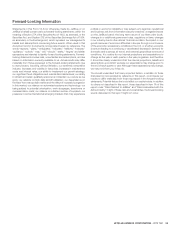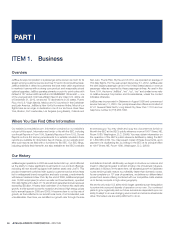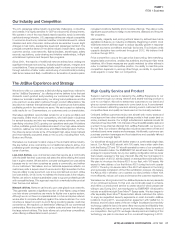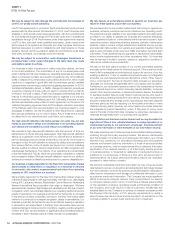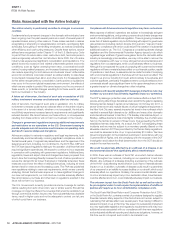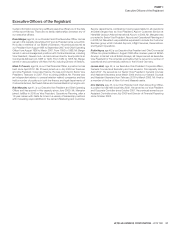JetBlue Airlines 2012 Annual Report Download - page 18
Download and view the complete annual report
Please find page 18 of the 2012 JetBlue Airlines annual report below. You can navigate through the pages in the report by either clicking on the pages listed below, or by using the keyword search tool below to find specific information within the annual report.
JETBLUE AIRWAYS CORPORATION-2012 10K14
PART I
ITEM1ARisk Factors
Iran Sanctions Disclosure
Pursuant to Section 13(r) of the Securities Exchange Act of 1934, or the
Exchange Act, if during 2012, JetBlue or any of its affi liates have engaged
in certain transactions with Iran or with persons or entities designated under
certain executive orders, JetBlue would be required to disclose information
regarding such transactions in our Annual Report as required under Section
219 of the Iran Threat Reduction and Syria Human Rights Act of 2012, or
ITRA. During 2012, JetBlue did not engage in any transactions with Iran
or with persons or entities related to Iran.
Deutsche Lufthansa AG, or Lufthansa, is a stockholder of approximately
17% of JetBlue’s outstanding shares of common stock and has two
representatives on our Board of Directors. Accordingly, it may be deemed
an “affi liate” of JetBlue, as that term is defi ned in Exchange Act Rule 12b-2.
In response to our inquiries, Lufthansa informed us that it does not engage
in transactions that would be disclosable under ITRA Section 219. However,
Lufthansa informed us that it does provide air transportation services from
Frankfurt, Germany to Tehran, Iran pursuant to Air Transport Agreements
between the respective governments. Accordingly, Lufthansa may have
agreements in place to support such air transportation services with the
appropriate agencies or entities, such as landing or overfl ight fees, handling
fees or technical/refueling fees. In addition, there may be additional civil
aviation related dealings with Iran Air as part of typical airline to airline
interactions. In response to our inquiry, Lufthansa did not specify the
total revenue it receives in connection with the foregoing transactions, but
confi rmed the transactions are not prohibited under any applicable laws.
ITEM1A. Risk Factors
Risks Related to JetBlue
We operate in an extremely competitive industry.
The domestic airline industry is characterized by low profi t margins, high
fi xed costs and signifi cant price competition in an increasingly concentrated
competitive fi eld. We currently compete with other airlines on all of our routes.
Most of our competitors are larger and have greater fi nancial resources
and name recognition than we do. Following our entry into new markets
or expansion of existing markets, some of our competitors have chosen
to add service or engage in extensive price competition. Unanticipated
shortfalls in expected revenues as a result of price competition or in the
number of passengers carried would negatively impact our fi nancial results
and harm our business. The extremely competitive nature of the airline
industry could prevent us from attaining the level of passenger traffi c or
maintaining the level of fares required to maintain profi table operations
in new and existing markets and could impede our profi table growth
strategy, which would harm our business. Additionally, if a traditional
network airline were to fully develop a low cost structure, or if we were to
experience increased competition from low cost carriers, our business
could be materially adversely affected.
Our business is highly dependent on the availability of fuel and subject
to price volatility.
Our results of operations are heavily impacted by the price and availability
of fuel. Fuel costs comprise a substantial portion of our total operating
expenses and are our single largest operating expense. Historically, fuel
costs have been subject to wide price fl uctuations based on geopolitical
factors and supply and demand. The availability of fuel is not only dependent
on crude oil but also on refi ning capacity. When even a small amount of
the domestic or global oil refi ning capacity becomes unavailable, supply
shortages can result for extended periods of time. The availability of
fuel is also affected by demand for home heating oil, gasoline and other
petroleum products, as well as crude oil reserves, dependence on foreign
imports of crude oil and potential hostilities in oil producing areas of the
world. Because of the effects of these factors on the price and availability
of fuel, the cost and future availability of fuel cannot be predicted with
any degree of certainty.
Our aircraft fuel purchase agreements do not protect us against price
increases or guarantee the availability of fuel. Additionally, some of our
competitors may have more leverage than we do in obtaining fuel. We
have and may continue to enter into a variety of option contracts and swap
agreements for crude oil, heating oil, and jet fuel to partially protect against
signifi cant increases in fuel prices; however, such contracts and agreements
do not completely protect us against price volatility, are limited in volume
and duration, and can be less effective during volatile market conditions
and may carry counterparty risk. Under the fuel hedge contracts we may
enter from time to time, counterparties to those contracts may require
us to fund the margin associated with any loss position on the contracts
if the price of crude oils falls below specifi ed benchmarks. Meeting our
obligations to fund these margin calls could adversely affect our liquidity.
Due to the competitive nature of the domestic airline industry, at times we
have not been able to adequately increase our fares to offset the increases
in fuel prices nor may we be able to do so in the future. Future fuel price
increases, continued high fuel price volatility or fuel supply shortages may
result in a curtailment of scheduled services and could have a material
adverse effect on our fi nancial condition and results of operations.
We have a signifi cant amount of fi xed obligations and we will incur
signifi cantly more fi xed obligations, which could harm our ability to
service our current or satisfy future fi xed obligations.
As of December31, 2012, our debt of $2.85 billion accounted for 60% of
our total capitalization. In addition to long-term debt, we have a signifi cant
amount of other fi xed obligations under leases related to our aircraft, airport
terminal space, other airport facilities and offi ce space. As of December31,
2012, future minimum payments under noncancelable leases and other
fi nancing obligations were approximately $1.02 billion for 2013 through
2017 and an aggregate of $1.33 billion for the years thereafter. We have
also constructed, and in October 2008 began operating, a new terminal
at JFK under a 30-year lease with the Port Authority of New York and
New Jersey, or PANYNJ. The minimum payments under this lease are
being accounted for as a fi nancing obligation and have been included in
the future minimum payment totals above.
As of December31, 2012, we had commitments of approximately
$5.00 billion to purchase 115 additional aircraft and other fl ight equipment
through 2021, including estimated amounts for contractual price escalations.
We may incur additional debt and other fi xed obligations as we take
delivery of new aircraft and other equipment and continue to expand into
new markets. In an effort to limit the incurrence of signifi cant additional
debt, we may seek to defer some of our scheduled deliveries, sell or lease
aircraft to others, or pay cash for new aircraft, to the extent necessary or
possible. The amount of our existing debt, and other fi xed obligations, and
potential increases in the amount of our debt and other fi xed obligations



